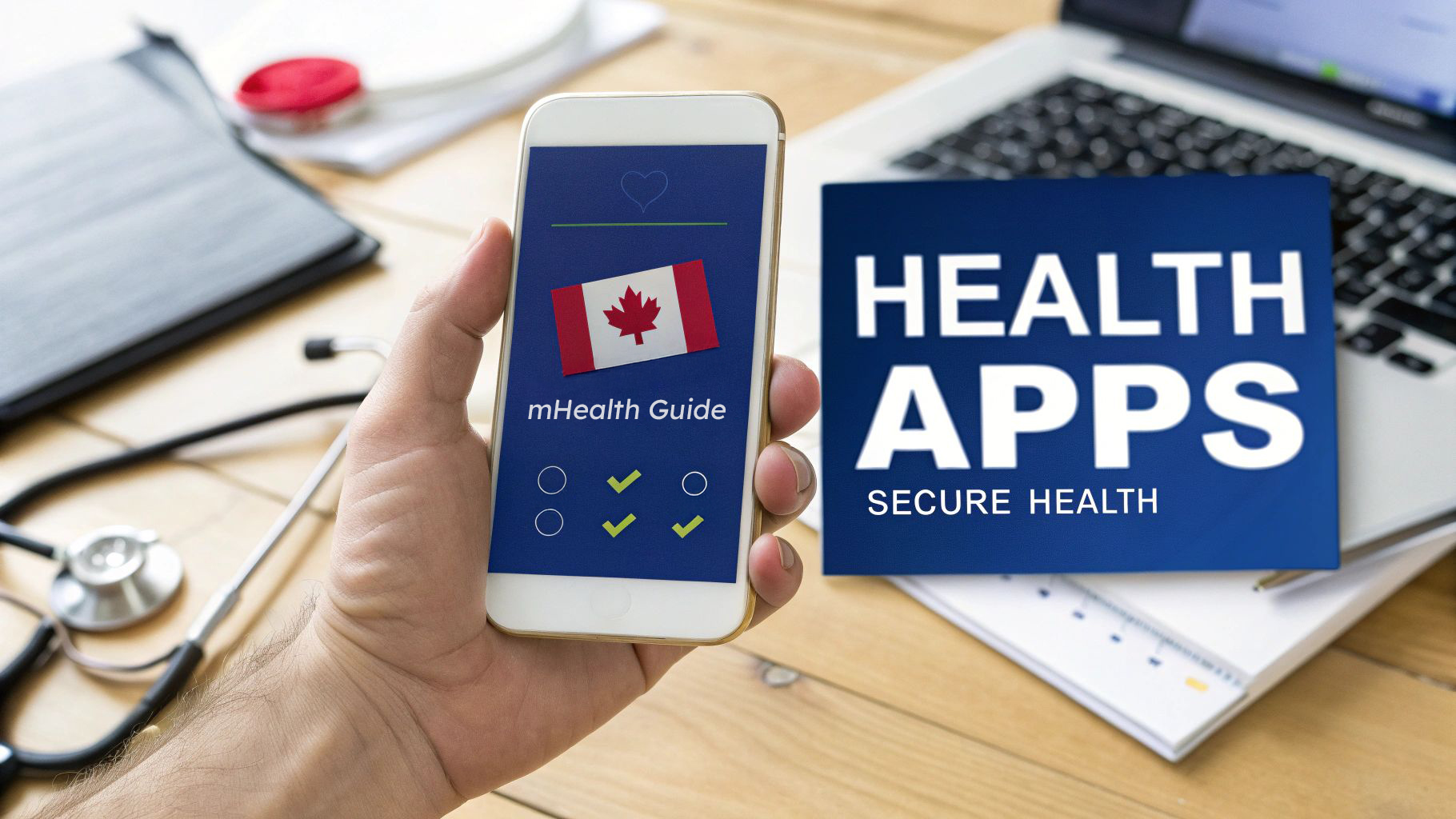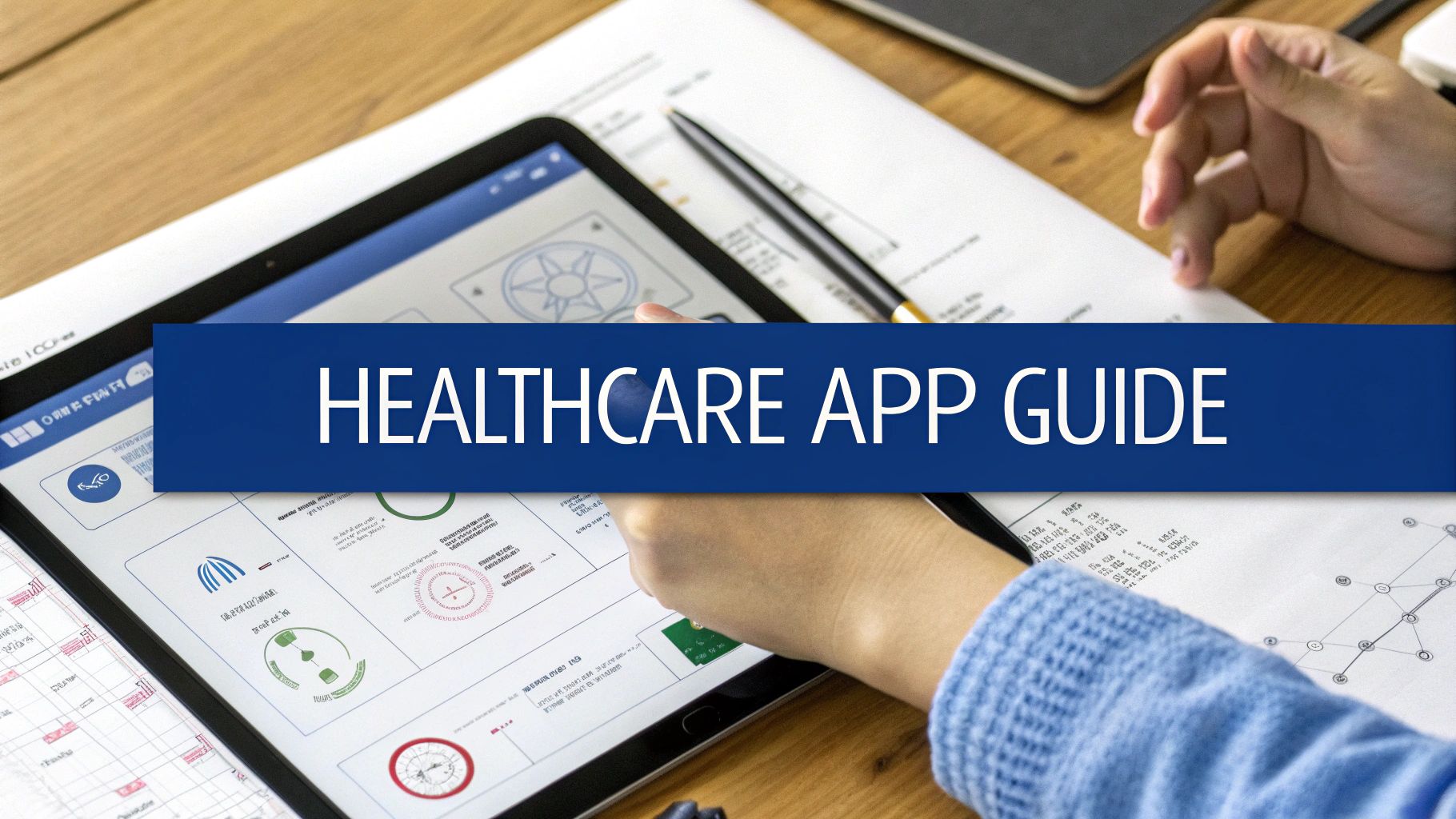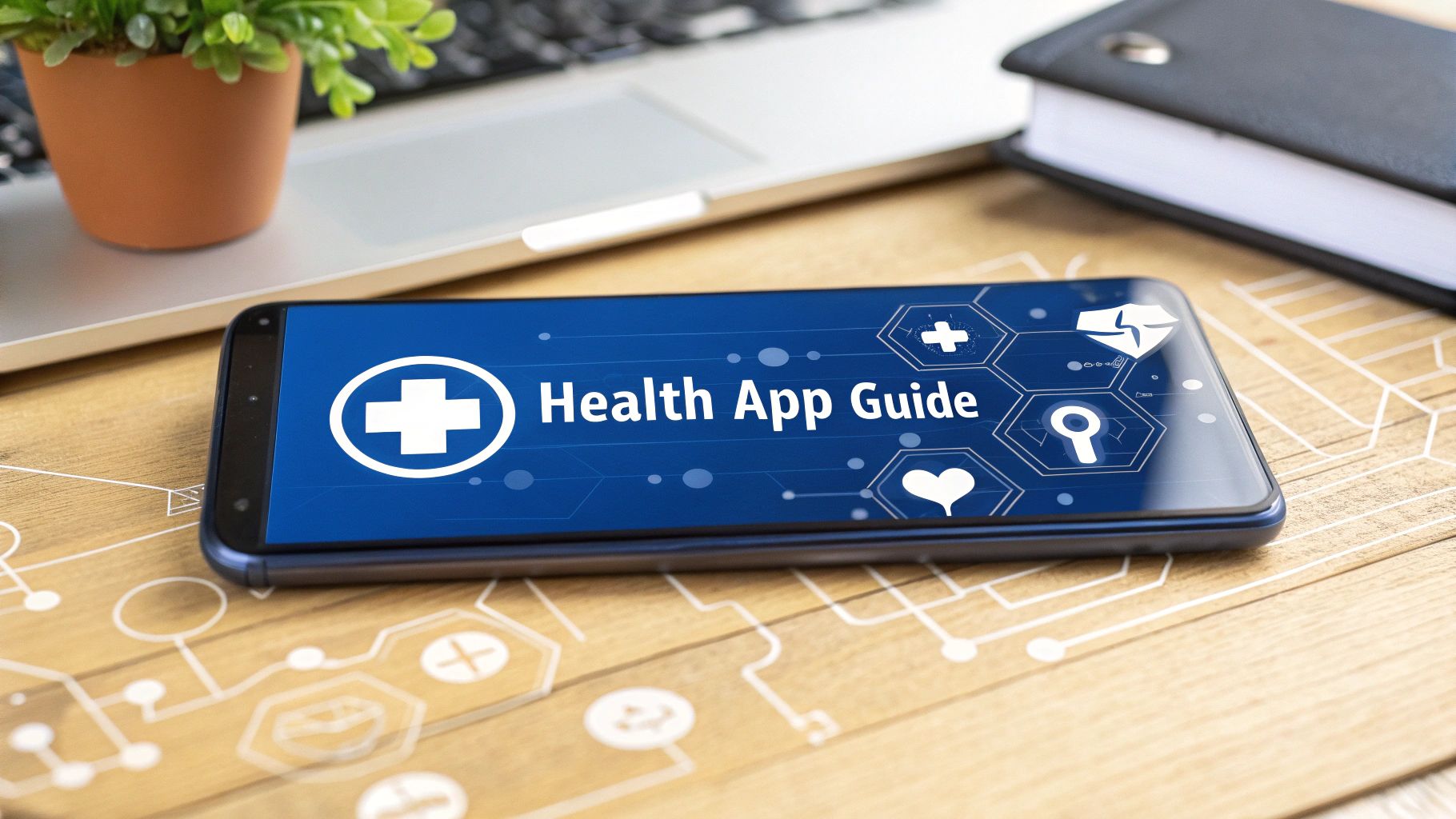Developing a healthcare app in Canada is about more than just slick code and a nice interface. It’s about building a digital health tool that fits perfectly within our country's distinct regulatory and patient care environment. You have to navigate a complex web of federal laws like PIPEDA alongside provincial data privacy rules to ensure every piece of patient information is locked down tight. When done right, the result is a wave of new apps that genuinely improve how Canadians access and manage their health.
The Urgent Need for Digital Health in Canada
The Canadian healthcare system is at a crossroads. We're witnessing a significant move away from the old model of strictly in-person appointments toward a more flexible, patient-focused digital approach. This isn't just a fleeting trend; it's a necessary evolution, pushed forward by changing patient expectations and the real-world pressures on our healthcare system.
Think about how banking has changed. We went from waiting in line for a teller to managing our finances from our phones. Canadians are now starting to expect that same level of convenience and control over their health. They want the ability to book an appointment, check their lab results, or talk to a doctor without the hassle of travel and waiting rooms.
This demand is lighting a fire under the market. The healthcare mobile app sector in Canada is booming, largely thanks to widespread smartphone use and the growing acceptance of remote care. While fitness and training apps still hold the biggest piece of the pie at 50.46% of revenue share, other areas are catching up fast. We're seeing huge growth in apps for booking appointments, ordering from online pharmacies, and monitoring patients from a distance. For those looking to innovate, this points to a massive opportunity in healthcare app development in Canada.
Why This Shift is Happening Now
So, what's driving this digital sprint? A few key factors are pushing us toward modern healthcare apps, and they go far beyond mere convenience.
-
Growing Demand for Virtual Care: For people in remote or rural communities, getting timely access to a doctor or specialist can be a huge challenge. Virtual care apps are closing that distance, making healthcare more accessible and equitable for everyone, no matter their postal code.
-
Government Modernization Initiatives: Both federal and provincial governments are pushing for digital health records and better system integration. The goal is a more connected, efficient healthcare network where information flows securely to improve patient care.
-
A Focus on Preventive Health: We're all becoming more aware of how important it is to manage our health proactively. Apps that help us track wellness, manage chronic diseases, and build healthy habits are empowering people to take charge of their well-being before problems escalate.
-
Advancements in Technology: The incredible progress in tech is opening up new doors for diagnostics and patient monitoring. To see just how much, you might be interested in learning about the benefits of AI in Canadian healthcare, which is truly changing the game.
Untangling Canada's Web of Healthcare Regulations
Building a healthcare app in Canada isn't like building any other kind of app. Here, compliance is the absolute foundation of everything you do, not just a box you tick before you go live. One small mistake in handling patient data can bring on serious legal trouble and, maybe worse, destroy the trust you have with your users.
Imagine patient data is locked inside a high-security digital vault. As a developer, you're responsible for building every single part of that vault, like the walls, the locks, the access protocols, and the alarms. This means turning dense legal jargon into real, practical steps for your development team. Getting through this maze isn't just a good idea; it's a non-negotiable part of healthcare app development in Canada.
The regulatory scene is a mix of federal and provincial laws, and you need to follow all of them. Getting this right from the start ensures your app is not only useful but also legally solid and trustworthy.
This decision tree gives you a bird's-eye view of the key signs of market readiness for a new Canadian health app, pointing to strong patient demand and government support.
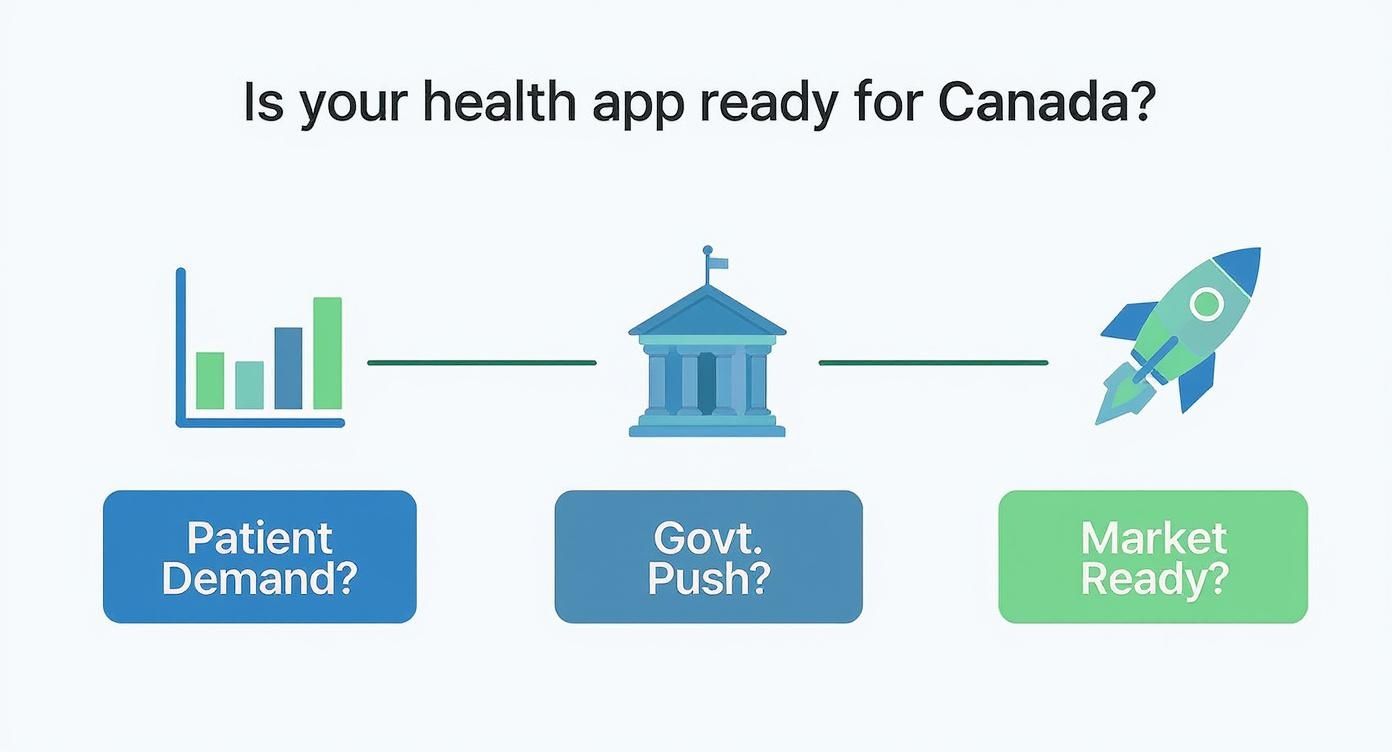
The data here really confirms it: the Canadian market is ready and waiting for new digital health solutions, pushed forward by both patient needs and official policies.
PIPEDA: The Federal Foundation
On the federal level, the main law you need to know is the Personal Information Protection and Electronic Documents Act (PIPEDA). This act sets the rules for how private companies collect, use, and share personal information in their business activities. For healthcare apps, "personal information" absolutely includes sensitive health data.
PIPEDA is built around ten fair information principles, which are basically the ground rules for handling data:
-
Accountability: You must name someone who is officially in charge of PIPEDA compliance.
-
Identifying Purposes: Be upfront about why you're collecting personal information before you ask for it.
-
Consent: Get clear and explicit permission from users before you collect, use, or share their data.
-
Limiting Collection: Don't grab more data than you actually need for the reasons you've stated.
-
Limiting Use, Disclosure, and Retention: Only use the data for its intended purpose and don't hang onto it forever.
-
Accuracy: Make sure the personal information you hold is as accurate and current as it needs to be.
-
Safeguards: Protect the information with security measures that match how sensitive it is.
-
Openness: Make your privacy policies easy for anyone to find and understand.
-
Individual Access: Users have the right to see their information and correct any mistakes.
-
Challenging Compliance: Have a straightforward way for users to make a complaint if they think you're not following the rules.
In practical terms, for your app, this means you can't just bury consent in a long-winded terms of service document. It has to be a distinct, clear action where a user knowingly agrees on how their specific health data will be managed.
The Provincial Patchwork: Health Information Acts
While PIPEDA sets the national baseline, healthcare is managed provincially in Canada. This means you also have to comply with a whole host of provincial health information acts, which are often even more stringent than the federal law.
Working through the tangle of provincial laws is often the trickiest part for developers. A feature that’s perfectly compliant in Ontario might not cut it in British Columbia or Alberta. A one-size-fits-all approach is a recipe for disaster.
Before you start building, it's essential to understand the specific laws in the provinces where you plan to operate. The table below breaks down the key regulations you'll encounter.
Key Canadian Healthcare Privacy Laws at a Glance
|
Regulation |
Jurisdiction |
Core Focus Area |
Key Requirement for Apps |
|---|---|---|---|
|
PIPEDA |
Federal |
Personal information in commercial activities |
Obtain explicit, informed consent for data collection. |
|
PHIPA |
Ontario |
Personal Health Information (PHI) |
Strict rules for consent, collection, and disclosure of PHI. |
|
HIA |
Alberta |
Health Information |
Governs collection and use by “custodians.” |
|
PIPA |
British Columbia |
Personal Information (including health) |
Data residency: Requires data to be stored in Canada. |
|
PHIA |
Manitoba |
Personal Health Information |
Rules for trustees handling health information. |
This patchwork means you have to be incredibly deliberate. For example, a major difference often comes down to data residency, where the data is physically stored. British Columbia and Nova Scotia, for instance, have laws that demand the personal health information of their residents be stored and accessed only from within Canada.
Because of this, one of the smartest moves you can make is to commit to using cloud servers physically located in Canada from day one. This single decision can simplify your compliance efforts across all provinces and immediately build trust with users who are rightfully concerned about where their data lives.
The privacy puzzle gets even more complex when new technologies are involved. You can get a better sense of these challenges by reading more on how AI impacts data privacy in Canadian healthcare.
Beyond data privacy, accessibility is another huge regulatory piece of the puzzle. To make sure you’re building an app for everyone, you need to get ahead of upcoming digital access rules. A fantastic guide on this is Navigating Canadian Web Accessibility Policies and WCAG. By making your app accessible to Canadians with disabilities, you're not just meeting a legal requirement; you're opening your doors to a much wider audience.
What Makes a Great Canadian Health App?
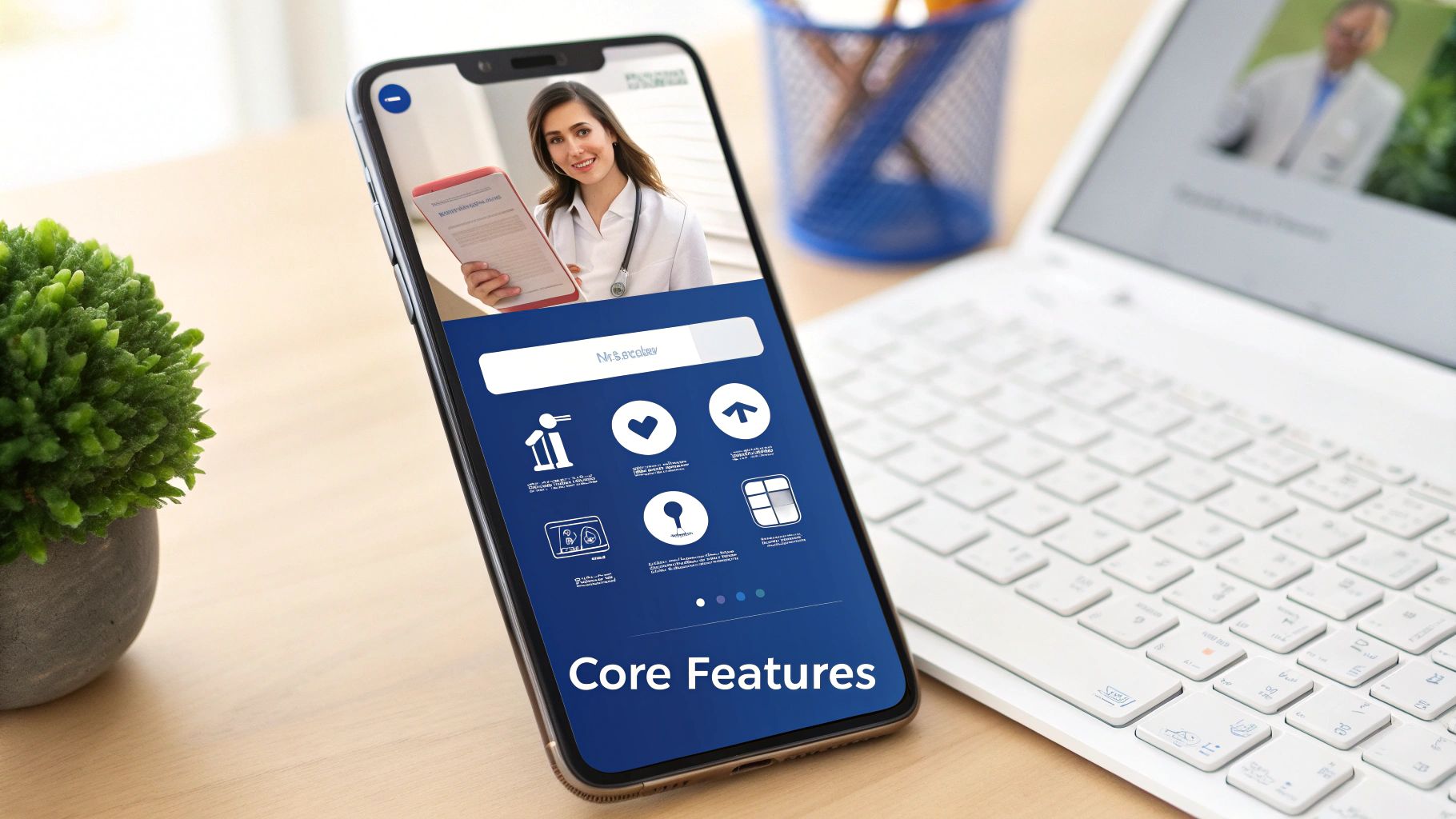
Ever wonder what separates a health app that becomes a trusted part of someone's daily routine from one that's deleted after one use? It's not just about a pretty interface. The real magic lies in delivering real-world value through a carefully selected set of features. For anyone building a healthcare app in Canada, this means combining universal best practices with features designed specifically for our country's unique health systems.
To build an app that truly connects with Canadians, you have to get inside the heads of both patients and providers. The end goal is to create an experience that’s secure, simple, and ultimately, empowering. We're talking about more than just a glorified booking calendar; we're talking about a thoughtful mix of security, convenience, and features that make sense here at home.
The idea of patients using digital tools is no longer a fringe concept in Canada. A 2023 report revealed that over 51% of Canadians aged 15 and up are already going online to check things like lab results and appointment details. This isn't just a trend; it's a clear signal of a national shift toward patient-centred care, a movement that’s gaining momentum with government support.
Start with Rock-Solid Security
Before you even think about flashy features, you have to build a fortress. In healthcare, trust is everything. A single data breach can torpedo your reputation for good.
-
Multi-Factor Authentication (MFA): A simple password just doesn’t cut it anymore. MFA adds a vital second layer of defence, like a code sent to a user’s phone, making it incredibly difficult for the wrong person to get in.
-
End-to-End Encryption: Think of this as an unbreakable code. Every piece of data, from a private message to a doctor to personal health records, must be scrambled both when it's being sent and when it's stored. If someone intercepts it, all they see is gibberish.
These aren't optional extras. They are the absolute foundation for protecting patient privacy and are essential for complying with PIPEDA and provincial health information laws.
Build a Core of Useful Features
With security locked down, you can start adding the features that will make your app indispensable. These are the tools that solve the most common headaches for patients and clinics.
A truly great app feels like a helpful assistant, not another chore. It anticipates what the user needs and makes complicated tasks feel effortless.
"The best healthcare apps don't just digitize old processes; they reimagine them. The goal is to remove friction, whether that's in booking an appointment, understanding a prescription, or communicating with a care provider."
Here are the must-have features that deliver value right out of the gate:
-
Intuitive Patient Profiles: This is the patient’s home base. It needs to be a secure spot where they can easily see and manage their personal info, medical history, allergies, medications, and insurance details.
-
Seamless Appointment Booking: A slick scheduling system is a game-changer. Patients should be able to see when their doctor is free, book a slot, get automatic reminders, and reschedule without a fuss.
-
Secure Provider Messaging: A direct, private line of communication lets patients ask quick follow-up questions and allows providers to share information without resorting to insecure email or endless phone tag. This feature alone can dramatically improve how care is coordinated.
-
Prescription Management: Features that let patients see their current prescriptions, request refills online, and get reminders to take their meds can make a huge difference in their health. To learn more about what it takes to build a successful medical app, you'll find great insights in this guide on the key things to consider when developing a medical mobile app.
Add a Canadian Touch
To really win in the Canadian market, your app needs to speak our language, both literally and figuratively. These features show you’ve done your homework on how our healthcare system works.
-
Provincial Health Card Validation: Building in a way to validate provincial health card numbers (like an OHIP number in Ontario or AHCIP in Alberta) confirms patient identity and cuts down on administrative headaches.
-
Bilingual Support (English and French): To be truly accessible to all Canadians, your app must work perfectly in both of our official languages. This isn't just polite; it's a necessity for widespread adoption.
-
Integration with Provincial Health Systems: This can be a tough nut to crack, but connecting your app to provincial portals (for things like lab results or immunization records) offers incredible value and helps create a single, unified experience for the patient.
Building a Secure and Scalable Technology Stack
Picking the right technology for your healthcare app is a lot like choosing the foundation and materials for a new hospital. You're not just building for today; you're creating a structure that needs to be incredibly secure, reliable, and flexible enough to adapt to new medical advancements down the road. Every single choice, from what the user sees to where the data is stored, has a direct impact on performance, security, and your ability to grow.
This is the central nervous system of your app. For healthcare app development in Canada, it absolutely has to be designed with security and compliance as the top priorities. A bad choice here is a potential breach of patient trust and a direct violation of Canada’s strict privacy laws.
Native vs. Cross-Platform Development
One of the first big forks in the road is deciding whether to go native or cross-platform. Think of it like this: building a native app is like commissioning a custom-built home, perfectly tailored to its specific plot of land (either iOS or Android). A cross-platform app, on the other hand, is like using a high-end, modular design that can be beautifully adapted to fit on either platform.
Building natively gives you unparalleled performance and full access to a device's hardware, think cameras, GPS, or biometric sensors. This can be crucial for apps that need serious processing power, like those doing real-time vital sign monitoring. The trade-off? You need separate development teams and codebases for iOS and Android, which drives up both the time and the cost.
Cross-platform frameworks like React Native or Flutter let you write your code once and run it on both operating systems. This can trim development costs by 25-30% and get your app to market much faster. For many healthcare apps focused on things like appointment scheduling, telehealth consultations, and managing information, this is an incredibly efficient way to go. If you're digging into the nitty-gritty, this guide on choosing your mobile app tech stack offers a much deeper dive.
To help you weigh the options, here’s a quick breakdown:
Comparing Native vs. Cross-Platform App Development
|
Factor |
Native (iOS/Android) |
Cross-Platform (e.g., React Native) |
Best For |
|---|---|---|---|
|
Performance |
Highest possible. Direct access to device hardware. |
Very good, but a slight overhead can exist. |
Apps requiring intense graphics, real-time data processing, or heavy device integration (e.g., advanced imaging). |
|
Cost |
Higher. Requires two separate codebases and teams. |
Lower. Single codebase reduces development costs by 25-30%. |
Startups, MVPs, and apps where budget and speed-to-market are key priorities. |
|
Time to Market |
Slower. Parallel development for two platforms. |
Faster. “Write once, deploy everywhere” model speeds up the process. |
Projects with tight deadlines or the need to validate a concept quickly with a broad audience. |
|
User Experience (UX) |
Best-in-class. Follows platform-specific design conventions perfectly. |
Excellent. Modern frameworks create a near-native feel. |
Apps where the user interface is the core differentiator and must feel perfectly at home on each OS. |
|
Maintenance |
More complex. Need to update and bug-fix two separate apps. |
Simpler. One codebase means one set of updates to manage. |
Most general-purpose health apps, like patient portals, telehealth platforms, and wellness trackers. |
Ultimately, there's no single "right" answer. The best choice really hinges on your app's specific features, your budget, and how quickly you need to launch.
Essential Components of Your Tech Stack
Beyond the native vs. cross-platform decision, your tech stack is a collection of tools that need to work together seamlessly. Every layer has to be chosen with an eye on security and future growth.
-
Frontend (The User Interface): This is everything your users see and touch. For cross-platform apps, frameworks like React Native (backed by Meta) and Flutter (from Google) are fantastic choices, known for creating smooth user experiences and having strong developer communities.
-
Backend (The Engine Room): This is where all the heavy lifting happens, processing data, authenticating users, and running the core logic of your app. Scalable and reliable frameworks like Node.js are very popular for their ability to handle real-time communication efficiently, making them perfect for features like secure chat or live video consultations.
-
Database (The Secure Records Room): Your database choice is absolutely critical for protecting sensitive patient information. PostgreSQL is a powerful, open-source database celebrated for its rock-solid security features. It must be configured to encrypt data both "at rest" (when it's being stored) and "in transit" (when it's moving between the app and the server).
-
APIs (The Secure Messengers): Application Programming Interfaces, or APIs, are the conduits that allow your app, backend, and any third-party services to talk to each other. These channels must be locked down using protocols like OAuth 2.0 to guarantee that only authorised users and applications can access patient data.
The Non-Negotiable: PIPEDA-Compliant Hosting
Last but certainly not least is where your app will live. For any Canadian healthcare app, this is a make-or-break decision. Provincial data residency laws and federal PIPEDA guidelines mean that storing patient data on servers physically located inside Canada is often a legal requirement.
Using a provider like Amazon Web Services (AWS) Canada or Microsoft Azure Canada, which have data centres in cities like Toronto and Montreal, is the safest and smartest path. This single decision streamlines your compliance efforts, dramatically reduces legal risk, and builds instant trust with Canadian users who are rightly concerned about where their health information is stored.
Designing an Empathetic User Experience

You can build the most secure, feature-packed healthcare app on the planet, but it will still fall flat if people find it confusing, cold, or intimidating. Let's face it: users often open a health app when they're feeling stressed or vulnerable. This is where the human element of healthcare app development in Canada isn't just a nice-to-have, but everything.
Building an empathetic user experience (UX) means designing for a genuinely diverse Canadian audience. We’re talking about everyone from tech-savvy millennials to seniors who might not be as comfortable with digital tools. The goal is to craft an interface that feels like a reassuring hand on the shoulder, not a sterile, clinical form.
Think of your app's design as its bedside manner. Is it a calm, helpful guide with a clear layout and intuitive navigation? Or is it a source of frustration? This isn't just about looking good; a thoughtful design directly boosts patient engagement, helps people stick to their treatment plans, and builds a powerful sense of trust.
Designing for Every Canadian
A truly user-centric design process starts by recognizing the vast spectrum of people who will use your app across Canada. This goes way beyond aesthetics and dives deep into genuine accessibility and inclusivity.
Here's what you need to be thinking about:
-
Age and Digital Comfort: Your interface has to be simple enough for an older adult managing a chronic illness, yet still feel snappy and efficient for a busy professional booking a quick appointment.
-
Accessibility Standards: Following the Web Content Accessibility Guidelines (WCAG) isn't optional. This means using high-contrast colours, offering resizable text, and ensuring your app works seamlessly with screen readers for users with visual impairments.
-
Language and Culture: To have a truly national reach, providing flawless bilingual support in English and French is non-negotiable.
Here's a little secret from the field: when you design for your most vulnerable users first, you end up creating a better, more intuitive experience for everyone.
What Drives Engagement in Canadian Health Apps
The demand for well-designed digital health tools is already here. Canadians are actively using apps to manage their well-being, and the numbers prove it. For instance, 2022 data showed that apps like Impulse-Brain Training were downloaded over 197,000 times. Others like PC Health and Flo Period Tracker also pulled in tens of thousands of downloads, showing a wide range of interest in everything from mental fitness to women’s health. If you want to dig deeper, you can explore the full research on mHealth app statistics to see just how engaged users are.
This data tells us something critical: the most successful apps solve real, specific problems in a way that feels almost effortless. They build trust through sheer reliability and simplicity, not by cramming in every feature imaginable.
An empathetic design anticipates what the user needs before they even have to think about it. It reduces their mental effort by making information easy to find, actions simple to complete, and the whole experience feel supportive instead of demanding.
At the end of the day, a thoughtful UX is one of the most powerful tools we have for improving health outcomes. When an app is easy to navigate, patients are far more likely to track their symptoms correctly, stick to their medication schedules, and stay in touch with their care team. It creates a positive feedback loop where better engagement leads to better health, proving that in this field, a compassionate design is often the most effective feature you can build.
Got Questions About Building a Healthcare App in Canada? We've Got Answers.
When you're diving into the world of Canadian healthcare app development, a lot of questions pop up. It’s easy to feel tangled up in costs, timelines, and the web of regulations. We get it. This section is designed to give you clear, straightforward answers to the questions we hear most often, so you can move forward with your project confidently.
Think of this as a no-nonsense FAQ, tackling the big topics head-on. We'll break down the complexities of budgeting, data storage, and getting the right approvals to help you make smart, strategic choices.
How Much Does It Really Cost to Develop a Healthcare App in Canada?
This is usually the first question on everyone's mind. The honest answer? It varies a lot. The cost to build a healthcare app in Canada really depends on its complexity, the features you need, and just how strict the compliance gets. There's no single price tag.
For a simple Minimum Viable Product (MVP) with just the core functions, like user profiles and a basic appointment scheduler, you’re likely looking at a starting range of $50,000 to $80,000 CAD. An MVP is a great way to test the waters and get your idea into the market without a huge initial investment.
But if you're aiming for a more advanced app, the budget will naturally be bigger. An application with features like real-time video consultations, integration with Electronic Health Records (EHRs), and top-tier security protocols can easily run from $150,000 to over $300,000 CAD.
A few key things drive these costs:
-
Technology Stack: Building separate native apps for iOS and Android is almost always more expensive than using a cross-platform framework.
-
Third-Party Integrations: Need to connect to an EHR system, a payment gateway, or a pharmacy database? Each integration adds another layer of complexity and cost.
-
Security Audits: This isn't optional in healthcare. Budgeting for thorough penetration testing and compliance audits is an absolute must.
-
Ongoing Maintenance: Don't forget to plan for life after launch. Staying compliant with PIPEDA and provincial laws is an ongoing commitment, not a one-time chore.
Where Does Patient Data Have to Be Stored?
This is a make-or-break question for compliance. While Canada's federal privacy law, PIPEDA, doesn't explicitly ban storing data outside the country, provincial laws add a crucial layer of complexity. This makes data residency a critical decision right from the start.
Specifically, provinces like British Columbia and Nova Scotia have laws that demand personal health information (PHI) be stored and accessed only within Canada. If you don't follow these provincial rules, you could face some serious legal trouble.
The undisputed best practice? Use cloud servers physically located in Canada. It cuts through the legal maze and instantly builds trust with your users. This one decision simplifies compliance across all provinces and sets you up for success.
Thankfully, the major cloud providers make this easy. Services like Amazon Web Services (AWS) and Microsoft Azure have data centres right here in cities like Toronto and Montreal. Using these Canadian servers means you can confidently meet data residency requirements and assure users that their sensitive information is protected under Canadian law.
What’s a Realistic Timeline for Building a Compliant App?
The timeline for development really goes hand-in-hand with the cost and complexity. A simple, focused MVP can often be ready for market in about 4 to 6 months. This covers everything from the initial discovery and design phases to development, rigorous testing, and the final compliance audit.
For a full-featured, enterprise-level healthcare app, you’ll need more time. These projects often take 9 months to a year, sometimes longer. The stages that almost always stretch the schedule are compliance and security testing. Unlike in other industries, you simply can't rush these steps. One data breach can lead to massive fines and completely destroy your reputation.
A phased approach is often the smartest strategy. Launching a solid MVP gets you to market faster and allows you to collect real-world user feedback. From there, you can incrementally add more advanced features in future releases. It's a great way to manage risk and ensure the final product is something people actually want and need.
Does My Healthcare App Need to Be Certified by Health Canada?
Whether you need a formal certification from Health Canada depends entirely on what your app does. This is a critical distinction to make very early on.
If your app is built to diagnose, treat, or monitor a medical condition, then Health Canada will likely classify it as "Software as a Medical Device" (SaMD). If that's the case, you absolutely must obtain a Medical Device Licence before you can legally market it in Canada.
On the other hand, many apps fall outside this category. General wellness apps, fitness trackers, simple appointment schedulers, and patient education portals typically don't need Health Canada certification.
It's crucial to get a regulatory assessment done right at the beginning of your project. Getting the classification wrong can lead to huge delays and legal headaches down the road.
We always recommend consulting with a legal expert who specializes in Canadian health regulations. Their guidance will ensure you're on the right compliance path from day one, saving you an incredible amount of time and money.
At Cleffex Digital Ltd, we live and breathe the complexities of Canadian healthcare app development. Our team has the expertise to build secure, compliant, and user-friendly applications that actually succeed in this unique market. Let's build the future of Canadian digital health together.
